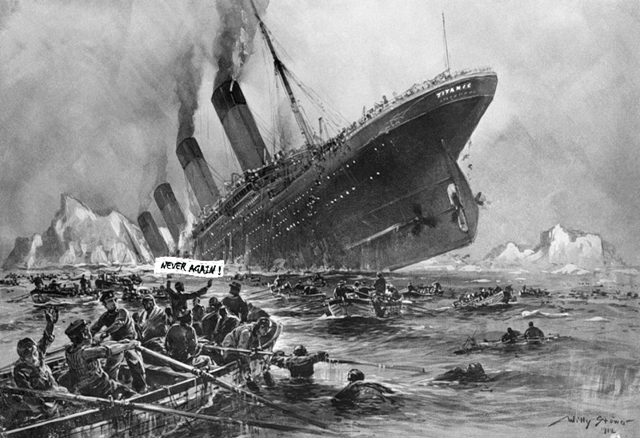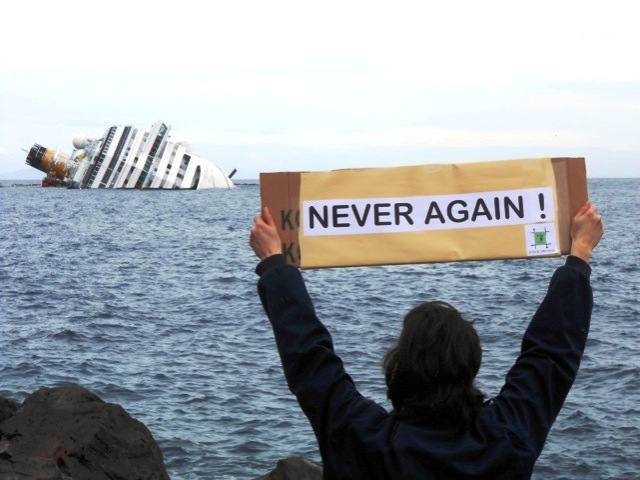Costa Concordia – Press release n°3
Giglio
The Gigantic was the name with which White Star Line christened its 3rd liner. The Gigantic was even bigger than the Titanic.
After the Titanic sank, the company changed its communications strategy, launching the Gigantic under the name Britannic in 1914.
|
The Titanic – From the painting by Willy Stöwer. April 1912. |
The Costa Concordia |
On 14th April 1912, the supposedly unsinkable Titanic hit an iceberg in the Atlantic Ocean and sunk in the night, leading to the deaths of 1,503 passengers and crew. One hundred years later, the Costa Concordia hit a rock and listed on the coast of the Mediterranean Island of Giglio with over 4,200 people on board (1).
Today, there are 97 liners that accommodate over 2,500 passengers navigating our seas, most flying the flags of convenience of the Bahamas, Panama, Bermuda and Malta. The Oasis of the Seas and the Allure of the Seas, owned by Royal Caribbean Cruises, can take up to 8,460 passengers and crew members on board. Of the 16 cruise ships under construction or on order, 13 exceed the 2,500 passenger threshold. This confirms the trend towards gigantism.
In view of this gigantism, International Maritime Organisation, stays where it is. Its regulations remain inadequate. IMO is reluctant to limit the size of these ships and sets its mind at ease claiming Gigantics are by themselves the best available lifeboat. If damage is encountered, they should be able to return safely to port.
Shipowners remain evasive when asked for specifics on the feasibility of evacuating thousands of passengers onto life boats, each of which can hold up to 370 people. In practical terms, it is a difficult procedure, which in some cases can be impossible: the Gigantic lists, it is dark, a quarter of the passengers are over 75 and there are many children on board. Some officials and experts believe that evacuating cruising ships in rough seas is simply impossible. The question remains unanswered and the 30 minutes rule to ordering evacuate thousands of passengers and crew is only theoretical.
In order to provide cruise industry customers the reassurance they desire, accident rates are compared with other modes of transport. Yet, the cruise ship is no longer a mode of transport; it is a holiday and leisure destination. To the usual risks associated with mass gatherings of people, including assaults and other incivilities, we must add the sea going risks. Accidents and shipwrecks have always happened in particular maritime circumstances.
Between 1998 and 2011, at least 6 fire outbreaks and fires were reported on board cruise ships transporting over 3,000 “guests” and crew members.
Collisions are another serious risk. They expose 3,000, 6,000, 8,000 potential victims to obligatory evacuation, broken limbs and other injuries, if not death.
Running aground is fairly common too; the Gigantics are adventuring into areas they really should not be going. The Costa Concordia is a perfect example of this.
Outbreaks of gastroenteritis and other infectious diseases are also relatively common. They spread to hundreds of people, including crew members, therefore inevitably reducing organisational and reactional ability in the event the ship’s safety is compromised in another way and the order to evacuate is given.
Gigantic are thus ideal sociological, symbolic, moral and numerical targets for terrorist projects.
Furthermore, these giants pollute our oceans and ports. In a single week, a cruise ship with 3,000 passengers and crew members on board produces around 800,000 litres of black water from toilettes, 4 million litres of grey water from showers, sinks and laundry facilities, 90,000 litres of bilge water mixed with hydrocarbons, over 800 litres of hazardous liquid waste, 40 tonnes of non-hazardous solid waste and 1 to 2 tonnes of hazardous solid waste.
Bottles and other forms of plastic packaging tend to get dumped in ports of call in countries where regulation on the matter is at its most lax.
These floating apartment blocks spoil the maritime landscape and historical towns.
The owner of the Costa Concordia has chosen to refloat the ship and then tow it towards Genoa, or another port, for it to be dismantled in a ship-breaking yard. It must be pointed out, however, that such a Gigantic ship-breaking yard does not yet exist in Genoa or else where in Italy. The final destination of the Costa Concordia, supposing that it is successfully refloated, is not yet clear. There is a real risk that this huge dustbin may be deliberately dumped in the Mediterranean, using force majeure as a cover story.
As a result, and given that shipowners and the IMO itself have shown no willingness to restrict the trend towards gigantism, Robin des Bois invites cruisers to boycott these Gigantics. The market is dominated by American Group Carnival Corporation and its subsidiaries Carnival Cruise Lines, Holland America Line, Princess Cruises, Costa Crociere (Italy), P&O Cruises (UK) and Aida Cruises (Germany) and American Group Royal Caribbean Cruises Ltd owner of Royal Caribbean International, Celebrity Cruises and Pullmantur Cruises (Spain). Then come the companies Disney Cruise Line (USA), Norwegian Cruise Line (USA), Star Cruises (Malaysia), MSC Cruises (Italy) and Tui Cruises (Germany). The cruise ships concerned are listed in the document attached.
Naturally, smaller cruise ships are not exempt from risks for safeguarding human life and protecting the environment; everybody should enquire into the age of the ship, its condition, its fire protection devices, its flag, its owner and its destination before committing themselves.
 Imprimer cet article
Imprimer cet article











